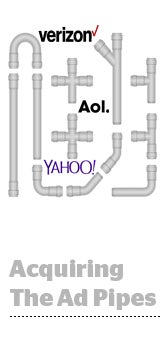 Verizon won’t complete its $4.8 billion acquisition of Yahoo until next year, but that hasn’t stopped speculation about which pieces of ad tech will come along for the ride.
Verizon won’t complete its $4.8 billion acquisition of Yahoo until next year, but that hasn’t stopped speculation about which pieces of ad tech will come along for the ride.
As Yahoo and AOL built their respective ad stacks to serve publishers and advertisers over time, obvious crossovers have occurred.
So what’s complementary, what’s redundant and what will help Verizon take the fight to Google and Facebook? Industry experts predict that the most natural fit between AOL and Yahoo’s respective offerings starts with mobile.
Millennial Vs. Flurry
AOL’s biggest mobile acquisition to date was Millennial Media, which it bought for about $300 million in September 2015. At the time, AOL billed that deal as a play for more mobile app monetization opportunities for developers.
About a year prior, in July 2014, Yahoo acquired mobile ad marketplace Flurry, which gave it mobile analytics chops. This platform, sources say, will be among the MVPs of Verizon’s move for Yahoo, from an ad tech standpoint. Flurry is also likely to be among the deal’s first points of integration.
Flurry has a “hardcore monetization structure for mobile apps, which is additive to the platform when you think about consumer interactions between apps,” said Tom Edwards, chief digital officer for Epsilon.
Millennial also dropped $107.5 million on Nexage back in September 2014, which added a mobile supply-side platform and access to new inventory to the mix.
As a result, Brian Shin, CEO of Visible Measures, predicts that Verizon will need to offer a common front end for all of its mobile supply sources.
“AOL/Yahoo will need to move toward a single exchange tech platform that would include mobile as well,” he said. “I would [bet it’s] Nexage that carries a lot of the load on the supply side. On the demand side, it could be Brightroll’s DSP or Adap.tv’s console or others.”
Adap.tv Vs. BrightRoll
Here’s where the redundancies start to rear up.
AOL united a number of video technologies under a single umbrella dubbed ONE by AOL: Video, which includes the video ad marketplace Adap.tv and connected TV targeting firm PrecisionDemand. It rolled other video-related assets, such as Vidible and AOL On, into a publisher-focused solution called ONE by AOL: Publishers.
“If you look at Advertising.com and AOL’s whole cross-screen network vs. BrightRoll’s programmatic web and connected device piece, overall there will be some overlap,” Edwards said.
Shin predicts that BrightRoll’s video ad exchange will be integrated into ONE by AOL as simply another supply source. BrightRoll also emphasized its private marketplace support over the years, as has AOL.
Will BrightRoll’s sell-side business suffer the same fate as its LiveRail, its former competitor on the supply side? After acquiring that firm, Facebook more or less shut it down.
Another source hypothesizes AOL will migrate BrightRoll Exchange’s best SSP customers to Adap.tv and shutter BRX’s buy side entirely.
Martin Kihn, a research VP at Gartner, said, “I’m sure there’s a lot of potential overlap and a technical nightmare to [overcome]. BrightRoll might be history.”
Meanwhile, AOL is still working to integrate its own acquisitions, both pre- and post-Verizon.
“Eventually, AOL will want to move to a single ad exchange tech platform (likely to be the Nexage technology and not Adap.tv’s), but we’ll see,” predicts Shin. “ONE by AOL was meant to bring things together, but in reality, there is a lot of tech still not fully integrated.”
Gemini Brings Native
Although AOL doesn’t own an exact complement to Yahoo’s Gemini on the native side, it has experimented with native mobile ad formats within the AdLearn Open Platform and via new video ad formats since the Microsoft/MSN integration.
Given Gemini’s main value prop – combining mobile search with native ad formats across sites and apps – Epsilon’s Edwards predicts AOL’s content properties will benefit from the native ad delivery component.
“It becomes a really compelling offering for consumers when you layer in native on top of both search and contextual display,” Edwards said.
Because AOL has also invested in personalized content in the past through its acquisitions of Gravity, Pictela and Kanvas Labs, Edwards envisions a connection between Yahoo’ s search and discovery strength – and Verizon and AOL’s own mobile video distribution efforts.
Future Stack Outlook: Unclear
AOL CEO Tim Armstrong has been a huge believer in ad tech over the years, and many seem to agree that AOL/Verizon bought Yahoo at least in part for its platforms.
“We believe there are some nice opportunities to roll YHOO video assets into Go90 and lump the ad tech/offsite volume with AOL’s,” wrote Dan Salmon, analyst for CMO Capital Markets, in a research note.
But he doesn’t think a combined Yahoo-AOL ad stack poses “a particularly new competitive challenge” to other leading exchanges, such as Google’s DoubleClick, Facebook’s Audience Network or AppNexus.
The value-add is likely to come not from the combined tech, but from the combined media and consumer data assets. But extracting that value will depend on getting the integration right.
Scott Ferber, who sold digital ad network Advertising.com to AOL in 2004, says that shouldn’t be a problem for Verizon.
“Acquisitions in this space almost always create some level of overlap,” he said. “AOL and Yahoo have experience in evaluating and managing these types of mergers. If this acquisition goes through, it will be up to AOL and Yahoo to determine what combination of products provides the greatest value to their clients and then begin the process of integration.”














